« From the 19th to 30th of April »
2 brothers reunited
We are back in Nairobi. This morning we pick up Nicolas at the airport. All the lights are green, we filled up with groceries and fuel the day before. On his side, he is well in the plane and will land in Nairobi at 8:55am.
We spent the night in a campsite half an hour from the airport. It is 8:10 am, Valentin puts the key in the ignition and we leave. Not so fast, the gate hardly passed, we feel big shakes on the asphalt road. Quickly, Laurène sees in the mirror that one of our wheels has a flat tire, the right rear one. It is our first puncture of the trip and of course, it has to happen to us one of the only days when we have appointment.



Neither one, nor two, one activates to invert it with our spare wheel stored in our gallery of roof. We park on the low side. The ground is a little sloping but that should pass. Valentin detaches the spare wheel padlocked on the roof. Failure! The key breaks in the lock. Fortunately, he succeeds in extracting the broken end and Laurène opens it with the double. We activate the bottle jack which lifts Uyo easily. Once the punctured wheel is removed, things get more complicated. With the slope, the new well inflated wheel touches the ground before arriving in front of the hub… we feel that we are not well awake and that we try to do things too quickly. We would better settle down to take the time to think. The jack is at its maximum height. No choice, it will be necessary to deflate the tire so that it passes. We have a compressor in the car. The operation turns out to be a bit longer and more complicated than expected. It is with 1 hour of delay that we arrive at the airport.
It is 10am, Nicolas embarks on board Uyo for the next two weeks. His first stop will be at the garage to repair the flat tire. A garage that we will visit again on his return to change a rear bearing that has some play. We plan to discover the volcanic and desert region of Turkana. A spare tire in good condition is essential to leave serenely on the rocky tracks that await us.

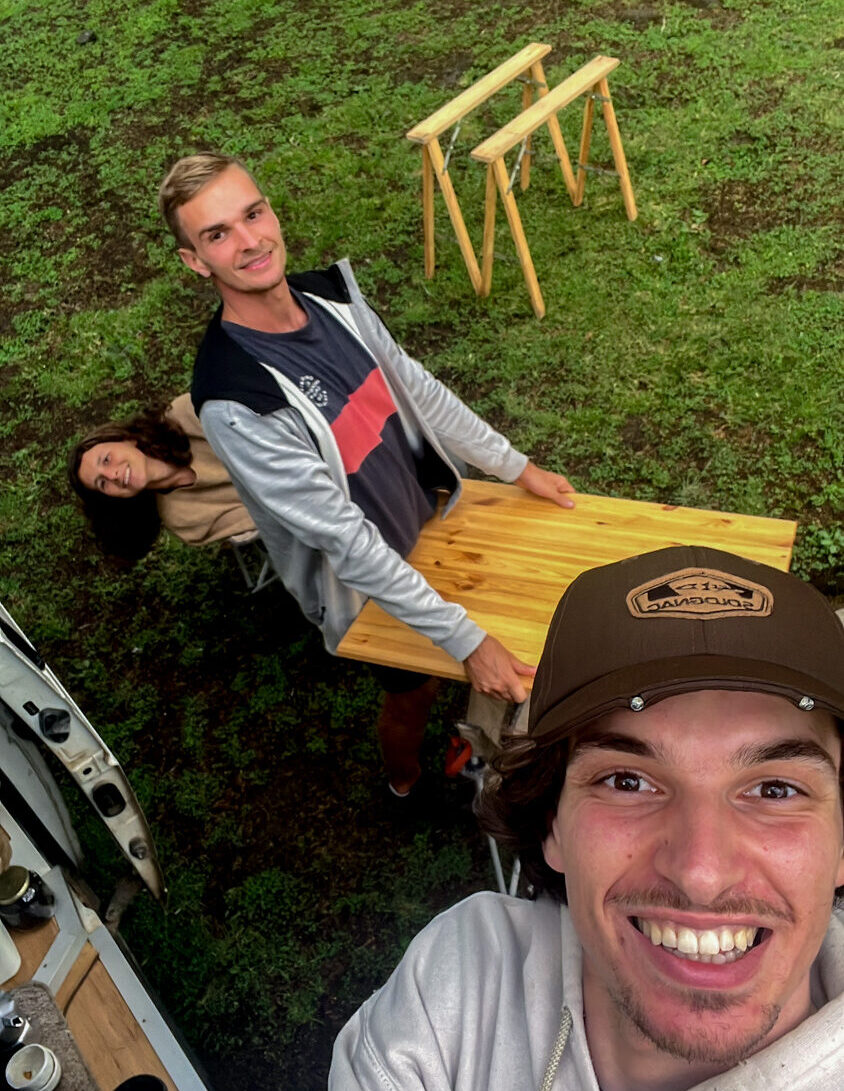

Small expedition to the lake Turkana
We have been amazed by the beautiful landscapes on our way to the North of the country.
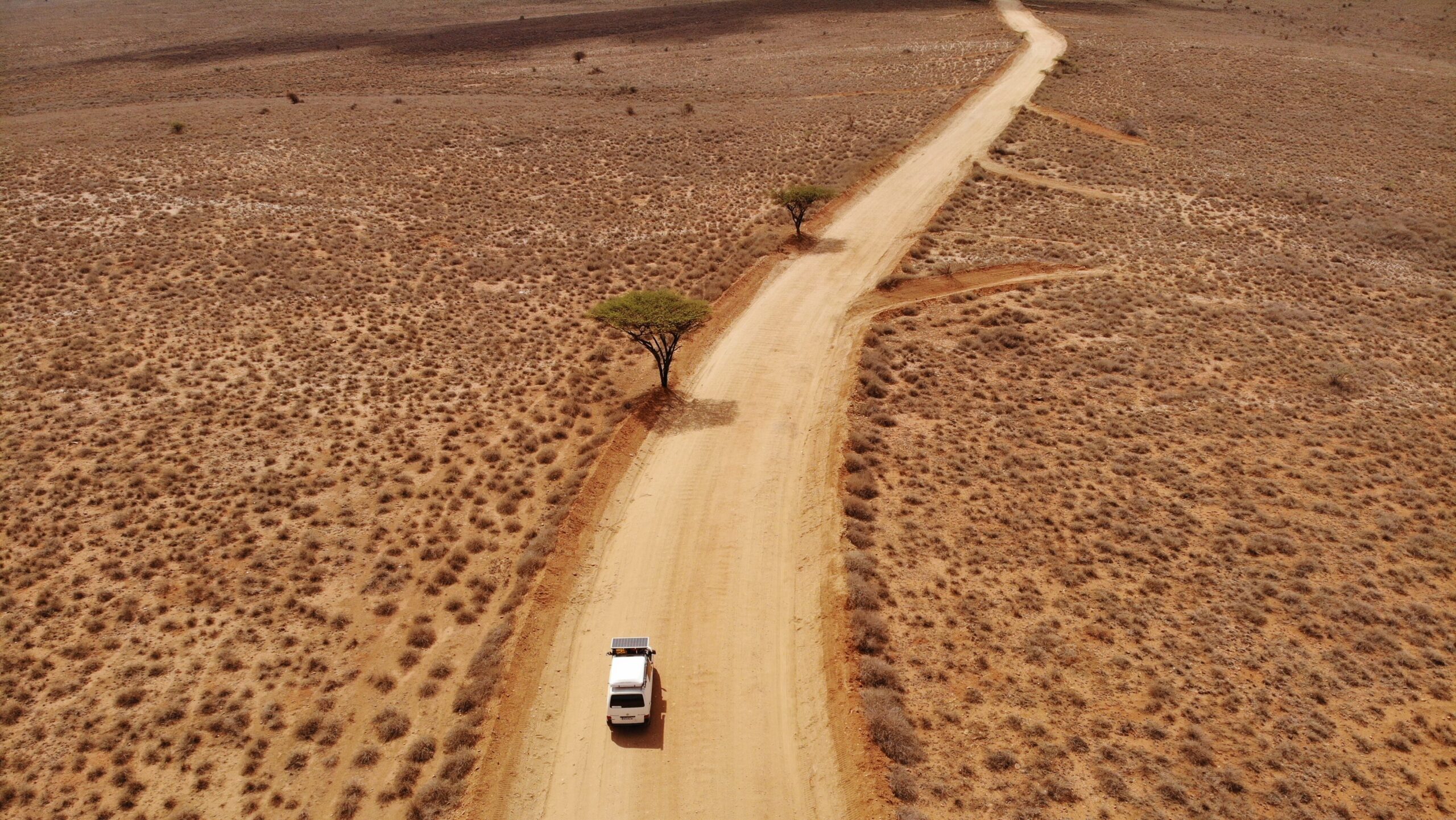
But the journey was tiring. The heat and the desert environment did not help. But the real difficulty comes from the road. Sometimes you have to go back to first gear to cross rocky areas and find the least steep passage. Sometimes the track seems to be smoother, but the corrugations shake the vehicle in all directions. You won’t be surprised to know that it took us 2 days to cover more than 230km of off-road.










The landscapes vary a lot over the last 200 km. They have for common point to be relatively desert. First of all, the colour of the sand dominates. Between the rocks and the soil many cactus bloom. We see our first camels. Then we find some greenery with the acacias. It is in the shade of one of them that we will spend the night. We are in a basin away from the track. Nicolas went to make photos around the camp. Laurène starts to install the solar shower outside. As for Valentin, he left armed with a shovel and a roll of toilet paper in search of a grove. But quickly, he sees people coming. A group of shepherds better armed than him with their Kalashnikovs, coming to meet us.
They are Samburu, a tribe of the North. They are 8 from memory. In addition to their dialect, they speak Swahili. We start the discussion with the few words we know. Then Google translate comes to our rescue to explain that we wanted to spend the night here. Smiling, they answer us that there is no problem. Before leaving, one of them approaches the van and asks us to eat. A packet of biscuit is enough to satisfy the whole group.
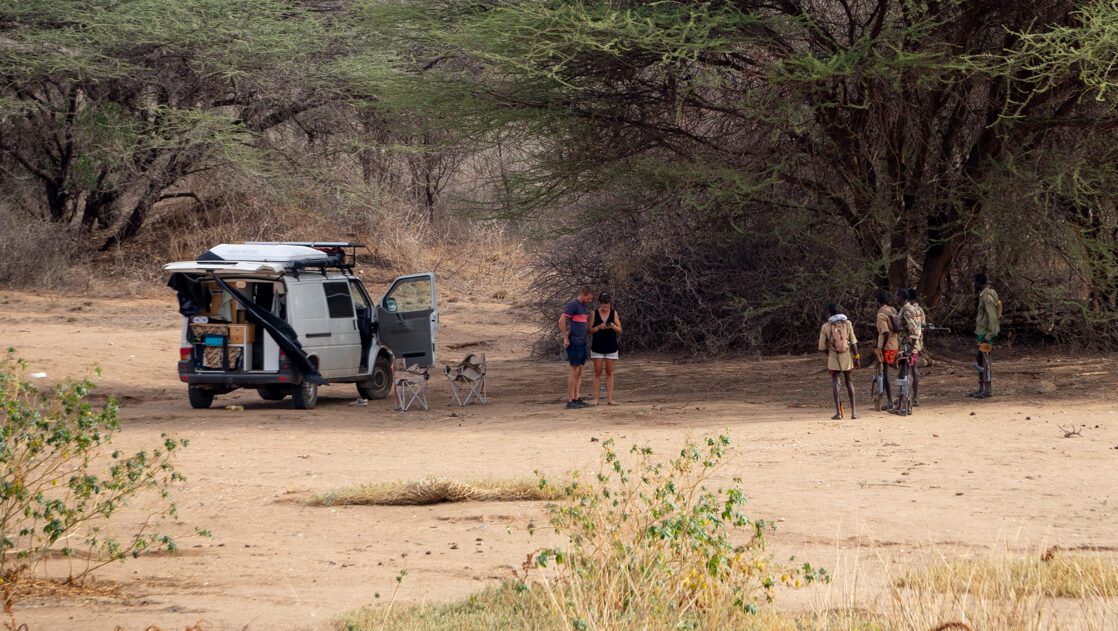
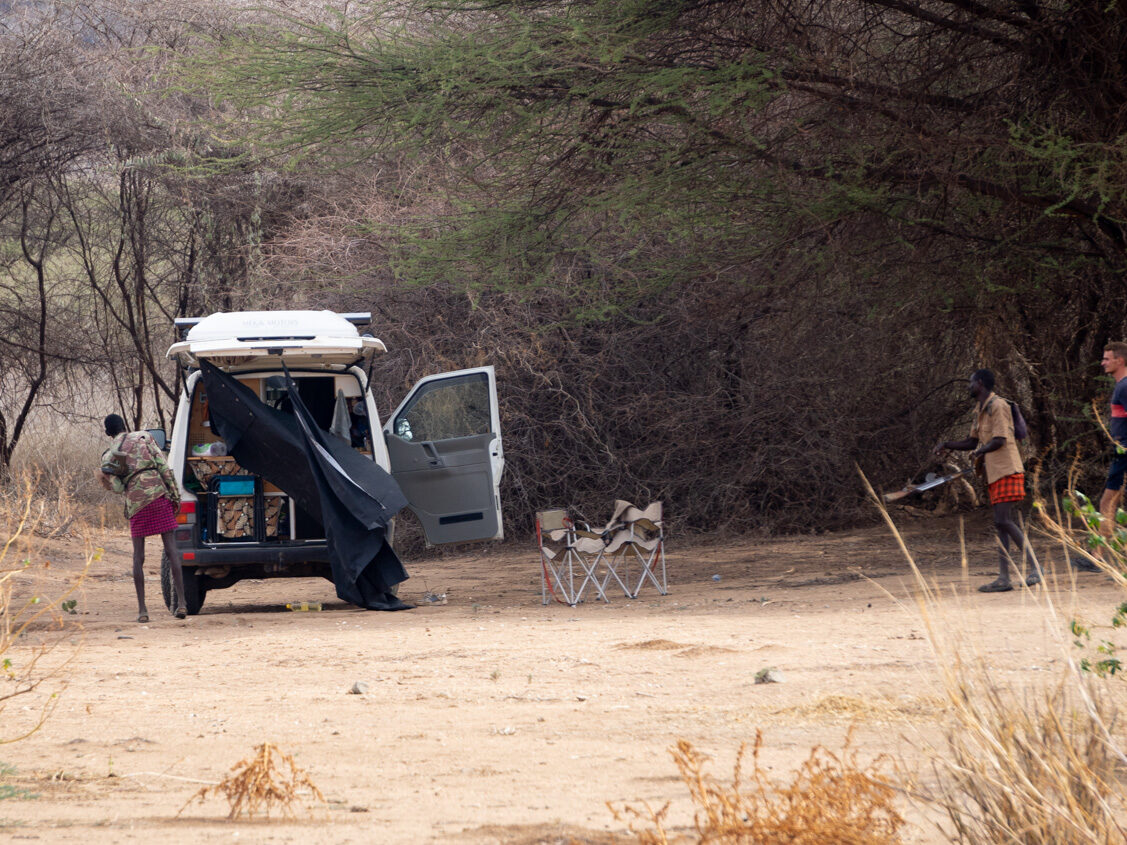
At the approach of the lake Turkana, the road is very hilly. Each time we reach the top of a hill, a new point of view is offered to us. It is while passing one of them that we suddenly plunge into a lunar universe dressed in black. The volcanoes of the valley of the great rift follow one another on the left. In front of us the intensity of the azure blue water appears under our amazed eyes. We start the descent to the shore of the biggest alkaline lake in the world. It is there that we find life. First of all two jackals which walk around in the black stones. Then a village as we have never seen before. It seems straight out of another planet, from a Star Wars movie, with its desert igloos. The tribes of the region live in small domes made of wood or metal frames, covered with cloth or dried plants. We are less than 20 kilometers from our destination, Loiyangalani. It is in Palm Shade that we install the camp for the next days.
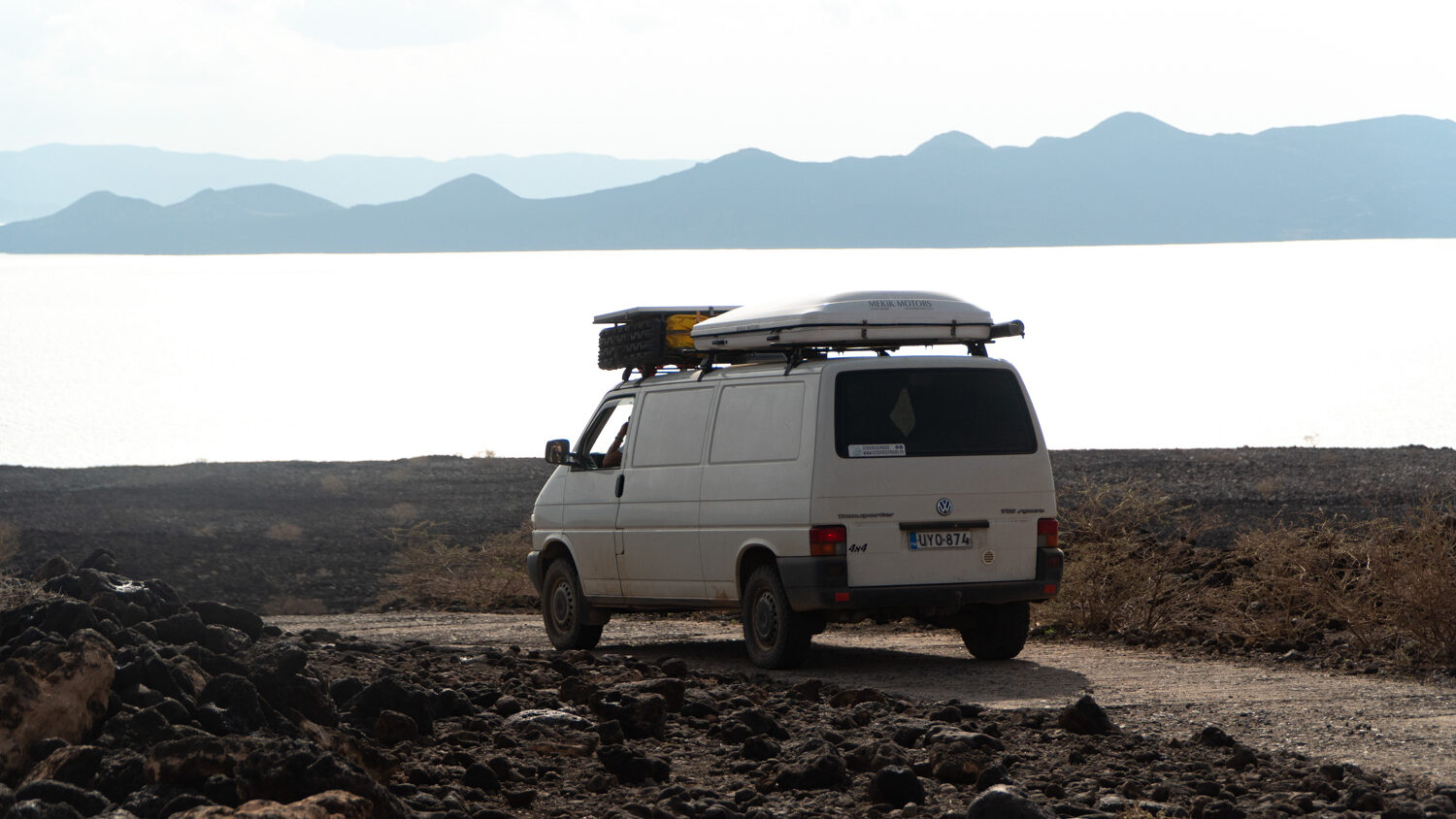








Lake Turkana tribes
This morning, we want to discover the village of Loiyangalani. Thanks to its oasis, it is the biggest village on this bank. The water source allows the trees, rare in this region, to grow.
We also find a great cultural mix. Five tribes live there in peace: the Turkana, the majority, but also the Samburu, the Relile, the Somali, and the El Molo who lived before on South Island. Although some cultures differ a little, the tribes are now linked by marriage.
Here are some anecdotes about the tribes that live in this village:
- A Turkana woman is expensive, 120 goats or 16 camels.
- Women wear a large necklace of multiple beads and colors to indicate that they are reserved for a man.
- Once the dowry is paid, she wears leaf-shaped buckles on top of their ears. Then once the marriage is pronounced, the husband must kill a bull. The woman then joins her husband’s tribe. Without this offering, the couple’s children will not be able to marry in their turn.
- The houses made of wood and straw are built by the women. They cost about 35 000 KSh (280€). They are built in the shape of a dome to protect from the strong wind in this region.
- The men sleep outside and the women in the house with the children.
- Turkana women have their hair shaved on the side and finely braided on the top of their head. The Samburu shave their heads completely.
- Women who come from a family that practices witchcraft wear a green and black necklace.
- Only some of the children in a family go to school. The young people must then dress in an urban fashion. Women do not wear necklaces and choose their hairstyles freely.
- Men can have several wives if they can afford to pay for them.
- They are afraid of photos. The belief that a photo captures a part of their soul is still very present.
After a very complete tour of the village thanks to our guide Lowoi, we return to the camp to prepare our activity of the next day.








South Island, the crocodile island
Early risen, we find Lowoi. The day before, he helped us to find a boat, to sail on the lake and to reach the big island, which we see from Loiyangalani. South Island is protected by the Kenya wildlife and therefore comes with a park entrance fee. Today, as often in the region, the wind blows strongly and the lake is agitated. The captain is confident and the boat is big enough to face the waves. The wooden boat is nevertheless very heavy and the small engine at the back is put to the test. The more we move away from the coast, the more the waves break. We do not stay dry for a long time. Far from us the desire to complain, with this heat and without shade, it is rather appreciable. Lowoi more relaxed than us, rolls and smokes cigarette on cigarette, when they are not wet. He has already spent half of our guide’s advance on tobacco. It takes us 1 hour to reach the deserted island.



South Island is certainly not a desert island as you imagine it. It is a volcanic island, rocky with black, brown and ochre stones. The climate is dry and hot. Of volcanic formation, it is shaped by mountains and craters. Their ascents offer different views of the large island of 10km long and the largest alkaline lake in the world. The other side of the island, out of access with the strong wind, shelters a colony of crocodiles in the bay.
It is the largest population of crocodiles in the world. It is estimated at 14000 individuals. They sometimes reach record sizes. We will not have the chance to observe them on the bank, too agitated during the day. So we took the opportunity to swim near the shore. Despite everything, we were a little bit afraid, knowing the numbers I told you, but reassured by the locals.







When we left, the island was a little less deserted. Six fishermen came out of their hiding place to see us. One of them wants to return to the mainland. They had remained discreet until now because they are in the illegality. Remember, the island is a protected area by Kenya wildlife. The young men stay on the island for a few weeks or months. Once they have accumulated enough fish, they can return to sell them and feed their families for the rest of the year.



The wind did not fall, the return will be as epic as the outward journey. When the boat pitches, our minds never stop thinking about the crocodiles. The waves in front of us slow down our progress and we cross our fingers that they have taken enough fuel to reach the coast. We all noticed that there is neither oar nor paddle. Let’s hope it doesn’t break down! To avoid increase our anxiety, Valentin had been careful not to say that the campsite manager was worried about the weather conditions. He concluded with “But if you have a good captain, it will be ok”. Anyway, we came back safe and sound before the night. In the evening, it is exhausted that we find our bed in Uyo.
Return through the desert and the mountains
We wish to make a loop to return to the south of the country. The track is better and the kilometers are a little faster. Contrary to the one of the outward journey, we cross many more villages populated by Samburu but without weapons this time. At the end of the afternoon, it is in the hollow of the mountains in the bush, that we establish the camp for the night. The villages are not far and the Samburu walk their herds of dromedaries in the corner. They do not delay to come to meet us one by one. The discussion repeats itself according to the same pattern. First greetings, then questions about our destination and finally the approval of our presence for the night. The language barrier often prevents us from going further. Nevertheless, our last visitor Jack is learning English at school.




Jack is a 14 year old teenager. He is currently taking care of his family’s camels. There are 3 of them, with his little brother and sister. For a week, they lead their herd of 30 camels into the wild. The herbivore feeds mainly on acacia trees like the giraffe. Jack likes our van. He speaks a little English and says “I like this picture” while talking about us in front of the van, before adding “I love this car”. He watches us cooking and asks questions about each ingredient. Tonight, it’s pizza and pasta. He knows pasta. He eats it from time to time unlike pizza. Mushrooms, cheese and peppers are unknown to him. He reads all the packages to learn the names of the foods in English. For fresh produce, we write the names in the dirt with his shepherd’s crook.
The falling night pushes us to return in the van. Jack goes back to his camp with the new flashlight we gave him. Hyenas are prowling around. Even if they represent essentially a threat for the cattle, it is necessary to remain careful.
The next morning, the teenager is back with company. We share our breakfast with 5 Samburu. The pancakes and tea are very appreciated, especially with a good dose of sugar. Before leaving, we go to see a herd of dromedaries. The animals scream like the dinosaurs of the Jurassic Park movies. They don’t appreciate the teeth cleaning inflicted by their masters.

The closer we get to the paved road, the more complicated the track becomes. The striations are more numerous and noises coming from the front right of Uyo are getting louder. Before our expedition to the north, we were starting to hear some very light rattling, but the hundreds of kilometers of track have accentuated it. We make some detours in the sand, to avoid the bad road.

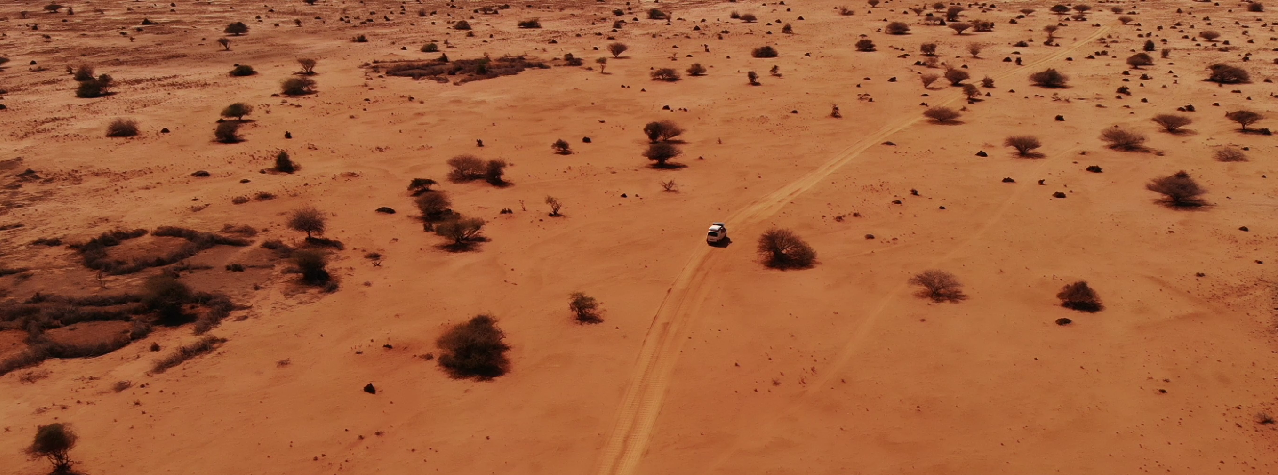


The difficulties intensify, whereas we thought we would soon arrive on the tarmac, we are blocked by a river. A truck got stuck last night while trying to take the muddy river passage. We offer water and cakes to the passengers who are blocked while waiting for the help which arrives. With them, we leave to look for a passage where the river bed is less deep. We find a way that seems technical but our pilot Valentin should be able to pass. At the command of Uyo, Valentin goes first and crosses the passage, creating a big spray of water and a new furrow. The small 4×4 track to get back to the main road seems quite simple after that. Back on the paved roads, our next step is to go down to the south of the country to visit Amboseli. This national park is located at the foot of Kilimanjaro.





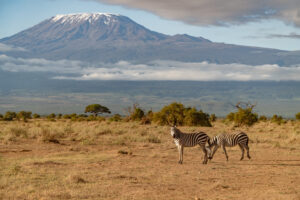
Pingback: #17 Amboseli, a safari at the foot of Kilimanjaro
Very interesting read. I visited Loiyangalani on or around 28th May, 22 on my Toyota Starlet.
Save, for a puncture that forced us to do around 100 kilometers on a flat tire, and getting stuck in the sand especially as you approach the big lagga at South Horr as well as the Malgis lagga the journey was epic.
We spent the night at Illaut at the foot of Mt. Poi and organized for a tire change although we had to then take the tire to Ngurunit to be inflated.
Our guide whom we picked at Laisamis Town was a Rendille and actually made the journey a success especially when we needed to get assistance from locals.
I recognized Lowoi from your pictures because he washed my little starlet for Kshs. 500.00/- which is triple the amount I normally pay in my hometown and later on took me to the lake shore for a swim.
All in all it was the most beautiful journey I have ever attempted and I think about it everyday.
Thanks for recording your story here.
Wow, what a great journey as well. Thank you for sharing your story with us ! It as been one of the most beautiful places we have been to also 🙂
Pingback: #28 Meeting with the beautiful women of Himba tribe Uyo's Passengers %